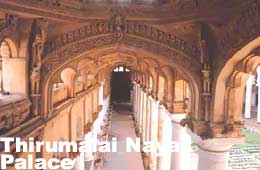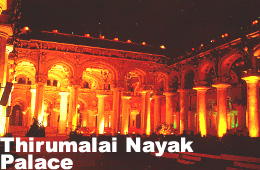| India Profile » Monuments and Temples in India » Thirumalai Nayak Palace, Madurai | |
Thirumalai Nayak Palace, Madurai | |
 | |
 King Thirumalai Nayak built the Thirumalai Nayak Palace in 1636 AD and was designed by an Italian architect. The palace is situated 2 km south east of the Meenakshi Temple. The building, which can be seen today, was the main Palace where the king lived. The original Palace Complex was four times bigger than the present structure. The Palace was the classic example of the Indo-Saracenic style of architecture. The palace was divided into two major parts, namely Swargavilasa and Rangavilasa. The royal residence, theatre, shrine, apartments, armory, palanquin place, royal bandstand, quarters, pond and garden were situated in these two portions. The courtyard and the dancing hall are the major center of attractions of the palace. High walls running 300 m from the east to the west, 200 m from the north to the south and 12 mt high enclosed the complex. These walls are called the Pari Madil and are said to have survived till a hundred years ago. The main palace has a rectangular courtyard flanked by tall arcades, each of which has a distinct carving. The original entrance was from the north but now a different entry is used which was repaired in the last century. The pillars supporting the arches are 12 m tall and are joined by foliated brickwork that carries a valance and an entablature rising up to a height of 20 m. The decoration is done in exquisite stucco called chunnam, (shell lime). The pavilions topped with finials that were covered with gold are on either side of the courtyard. Swargavilasa or the celestial pavilion stands to the west of the court spanning 75 m from the north to the south and 52 m across. 12 columns, enclosing a square 21 mt across, support the central dome. The columns are joined together with massive Saracenic arches. Four arches are thrown across the corner out of which the octagonal drum rise, pierced by a clerestory. The octagon changes to a circle 15 m beyond this and the dome rises in the center to a height of 25 m from the floor. The celestial pavilion is accessible by a flight of steps guarded by stone horse riders that are now damaged. The stuccowork on its domes and arches is noteworthy. The huge pillars and structures represent the awesome architectural supremacy of the Nayak Kings. There are around 248 pillars of each 58 feet toll and 5 feet diameter. Furniture and utensils used by the kings have been exhibited inside the palace. To the west, is a square building of black stone, in an outstanding dome-shaped hall, which have a chamber made of ivory inside it. A bejeweled throne was installed here, which the king graced during the Navaratra festivities. The harem and the queen's apartments were located to the west of Swargavilasa. None of which exists today. However, in the southwest part of the complex a morning room with black polished columns exists even today where the queen used to listen to music and literary discourses. The natakshala was a splendid hall measuring 22 m in length and 42 m in width in the northwest corner of the building. The roof is a pointed arch of brickwork strengthened by granite ribs springing from a double line of arches supported by columns. The palace shrine was located to the northeast of the building where Thirumalai Nayak offered prayers to goddess Rajrajeswari every morning. The shrine is richly carved in stone and the dome was covered with gold. The grandson of the king Thirumalai Nayak, Chokkanatha Nayak, demolished much of this palace and transferred the precious jewels and woodcarvings so that he could use it to build his own palace at Tiruchirapalli.  In the 19th century AD, Lord Napier, the Governor of Madras made several restoration works between 1866 and 1872 AD. The palace was to house some officials of the judiciary and district administration. The only surviving buildings of the palace are the Swargavilasa and a few adjacent edifices but their awe-inspiring splendor has vanished. The courtyard is a square measuring 3,900 m and is surrounded by massive circular pillars. The Throne Chamber is a vast room with a raised, octagonal dome lies to the west. The throne Chamber leads to the Dance Hall. After independence, the Thirumalai Palace was declared as a national monument and is now under the protection of the Tamil Nadu Archaeological Department. The time for the visit to the palace is from 9 am to 5 pm on the payment of the entrance fee. The palace is well equipped to perform Light & Sound shows depicting the story of Silappathikaram in both Tamil and English languages. The show is for half an hour glorifies the merits of the King Thirumalai emphasizing particularly on his passion for arts, his victories in battle and his love for his subjects. |
|
 |